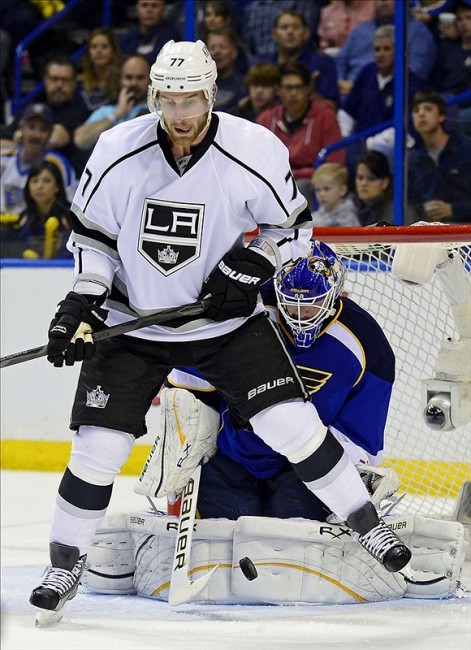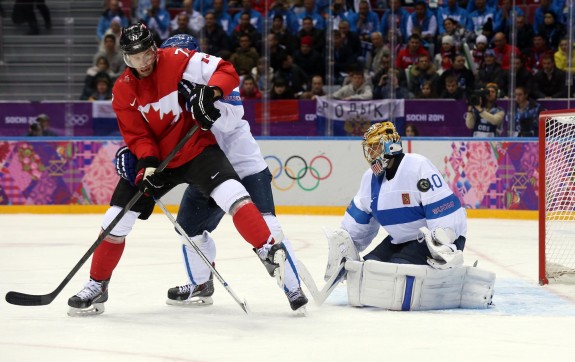
Friday’s Olympic men’s hockey action at the Winter Olympics in Sochi proved two things. First of all, both Team Canada and Team Finland are serious medal contenders. After coming out sluggish on Thursday in their preliminary round 3-1 win over Norway, Team Canada sprung to life in their second game and shut out Austria 6-0. The Finns also easily disposed of a Norweigan squad with only one active NHL player on its roster (Mats Zuccarello of the New York Rangers) by a 6-1 final score, which set up a Canada vs. Finland showdown on Sunday between Group B’s two undefeateds (Canada ended up winning that contest 2-1 in overtime, with both goals going to L.A. Kings blueliner Drew Doughty).
However, the two games also offered irrefutable proof of what hockey fans out west already know yet many puck pundits back east still refuse to fully acknowledge: There is no tougher division in the NHL right now than the Pacific Division. Of the combined 12 goals for the Canadians and Finns on Friday, eight were scored by players currently skating for Pacific Division teams: specifically the Los Angeles Kings, the Anaheim Ducks, and the Phoenix Coyotes.
Jeff Carter’s Shining Moment
Forget Valentine’s Day. Going forward, Canada ought to designate February 14 as Jeff Carter day instead. The 29 year old London, Ontario native scored the first natural Olympic hat trick since 1988 in Team Canada’s trouncing of the Austrians. All three of Carter’s goals came in the second period, all unanswered, all within 12 minutes of each other. In fact, Carter’s first two goals were only 90 seconds apart, although his second was no doubt aided by Austrian netminder Bernhard Starkbaum’s slipshod attempt at puck handling while in net. When not dressed in a Team Canada uniform, Carter skates on the top forward line for the Los Angeles Kings. In his nine year playing career with the Kings and the Philadelphia Flyers (with a brief 15 game pit stop with Columbus in between), Carter has registered 447 total points (248 goals, 199 assists) including 37 so far this season in 49 total games played. Carter was also a member of the Kings’ 2012 Stanley Cup championship team and was selected to the NHL all-star game in 2009 in the midst of a season as the leading scorer for the Flyers.
Carter is a first time Olympian for Team Canada, but he is no stranger to international play. Before his skates even touched NHL ice, Carter tied a record as Canada’s all-time leading scorer at the World Juniors, and he was named to back-to-back WJC tournament all-star teams. He also played for Canada at the 2006 IIHF World Championship.

Yet Carter was not the only Los Angeles Kings skater to light the lamp for Team Canada in the shutout win over Austria. Blueliner Drew Doughty actually opened the scoring barely five minutes into the opening period after winning an offensive zone faceoff and then taking the pass from Jonathan Toews. Ironically, Doughty also originally hails from London, Ontario. He also won the Stanley Cup with the Kings in 2012, and prior to that, he was the youngest member on Team Canada’s gold-medal winning 2010 Olympic squad in Vancouver. Doughty also scored a goal in the opening game versus Norway, and he made his NHL debut with the Kings in 2008 when he was only 18 years old. A solid two-way player, Doughty already boasts 214 career points in six seasons with the Kings (57 goals and 157 assists) and is playing at a +16 so far this season with 30 points at the Olympic break. Despite recent offensive struggles, the Kings have maintained playoff position at third place in the Pacific Division, largely due to stellar defensive efforts from players like Doughty, who averages well over 25 minutes of ice time per game on the top blueline pairing.
To everyone in Canada, you're welcome.
— LA Kings (@LAKings) February 14, 2014
Ducks Dynasty and a Coyote KOR-pedo

The Los Angeles Kings weren’t the only NHL Pacific Division powerhouse to put its scoring prowess on display Friday for the entire world to see. Two skaters from the division-leading Anaheim Ducks also lit the lamp, including Olympic veteran Teemu Selanne, who opened the scoring for Team Finland. In yet another milestone for the “Finnish flash” during what he claims will be his final Olympics, as well as his last season in the NHL before retiring, Selanne set a record as the oldest player to score a goal in the history of Olympic hockey (43 years, seven months, and 11 days to be exact). In addition, his Anaheim teammate Ryan Getzlaf chipped in a short-handed goal for Team Canada to provide extra insurance after Carter’s hat trick.
In addition to Selanne’s milestone, the Finns also capitalized off of two goals on Friday from forward Lauri Korpikoski, who plays for yet another Pacific Division team, the Phoenix Coyotes. Korpikoski’s first strike came barely once minute after Selanne put the Finns on the board, and he added a another goal just over eight minutes into the second period. The 28 year old native of Turku, Finland, was originally drafted by the New York Rangers in 2004 and traded to the Coyotes before the start of the 2009-10 NHL season.
It's a 6-1 final for Finland over Norway. Lauri Korpikoski fueled the Finn win w/ 2 goals, +3. Way to go, Korpi! pic.twitter.com/5IiX20hYPL
— Arizona Coyotes (@ArizonaCoyotes) February 14, 2014
Easier Out East
Even before opening ceremonies commenced in Sochi, the NHL standings going into the Olympic break leave no question about which of the four divisions is the NHL’s most dominant. Both the Anaheim Ducks and San Jose Sharks are amongst the top five teams in the overall league standings. Even though the Sharks are fourth overall in the Western Conference, the would be in second place if they played in the Eastern Conference. The Phoenix Coyotes are just out of wildcard contention playing in the west, but they would be in contention if they played in the east. The Boston Bruins are currently perched atop the Atlantic Division, but would only be in third place in the Pacific Division.
The Eastern Conference teams get far more national television coverage, in both the United States and Canada, than the Western Conference teams. This will no doubt continue, since some of the more popular Eastern Conference teams (i.e. New York Rangers, Philadelphia Flyers, and Washington Capitals) play in areas with a larger fan base and in cities where hockey is more popular, despite the fact they are having mediocre seasons at best and would not even approach playoff contention if they played in the Western Conference. Nonetheless, the Olympics have thus far provided an opportunity for people to witness first hand, on the world stage, that the Pacific Division is the most dominant in NHL, with far more dominant players.
Additional Note: On Saturday, Team USA defeated the host Russians 3-2 after a dramatic eight round shootout. Both of Team USA’s regulation goals were also scored by players from the NHL Pacific Division (Joe Pavelski of the San Jose Sharks and Cam Fowler of the Anaheim Ducks).
Follow Casey Gagnon on Twitter @CaseyPSH